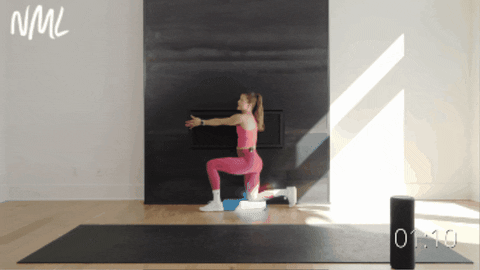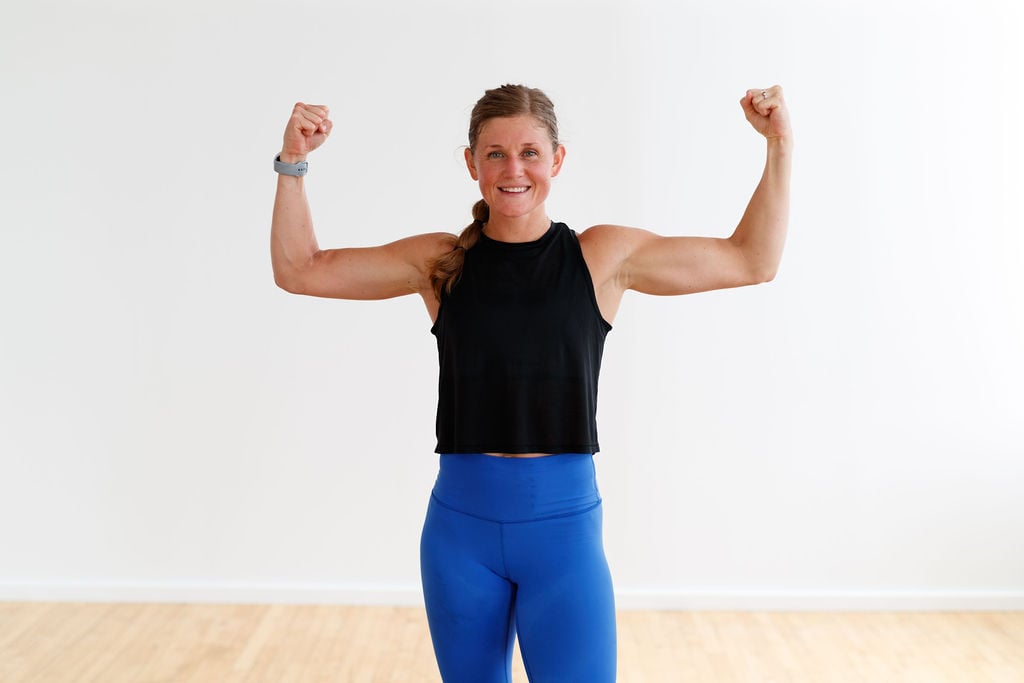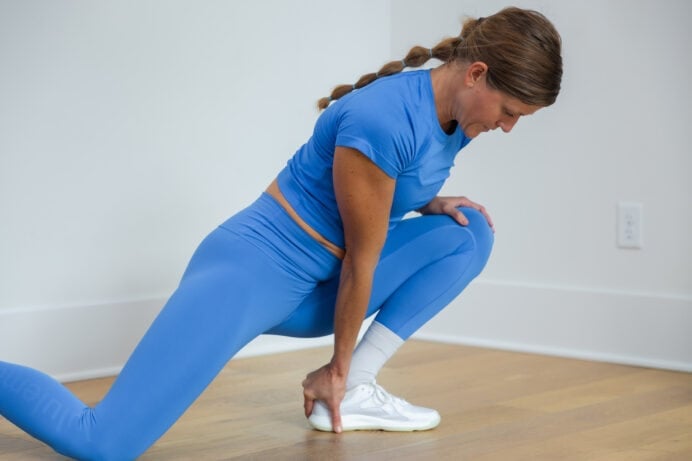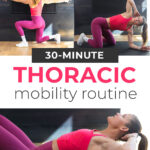
5 Best Thoracic Mobility Exercises
Reduce neck and back pain, improve range of motion, and increase overall daily functional strength with these guided thoracic mobility exercises. The thoracic spine, or t-spine, is the longest portion of the spine found in the upper back. This area is commonly tight and painful for people who work desk jobs – which can lead to poor posture, upper back pain, and difficulty breathing.
If you spend your day hunched over a desk or babies, you need to include these thoracic mobility exercises in your daily routine.
I personally started focusing more on my own mobility routine after experiencing a meniscus tear and the following knee surgery. While recovering from surgery, I began to experience more back and neck pain, likely due to muscle imbalances and being more sedentary.
These are the thoracic mobility exercises I now include in my daily routine, designed to reduce pain and increase range of motion, flexion, extension, and rotation through the upper back.
The thoracic spine, or “t-spine”, is the upper and middle part of our spines, and designed to both offer spinal stability and movement through the upper back. Tightness in this area of the spine can limit our range of motion, lead to poor posture, and even cause difficulties with breathing.
Good thoracic spine mobility is essential for our everyday activities, such as overhead lifting, bending, and twisting.

5-Minute Thoracic Mobility Routine
Five of the best thoracic mobility exercises to improve thoracic spine mobility and reduce pain in the middle back and upper back.
I suggest incorporating mobility workouts like this one to your home workout plan 1-2 times per week to protect and maintain healthy joints and muscles.
Workout Equipment:
Foam Roller. Or substitute a throw pillow.
Workout Instructions:
Follow along with the guided Thoracic Mobility Routine Video on YouTube, led by certified personal trainer Lindsey Bomgren.
Your Workout Looks Like This:
- 5 Thoracic Mobility Exercises
- Timed Intervals (40 seconds of work, 20 seconds of rest)
- Perform Each Mobility Exercise x1 (no repeats)

Prefer to Watch On YouTube?
Workout Outline
- Thoracic Spine Extension
- Cat/Cow Pose
- Table Top Thoracic Rotation
- Thread the Needle
- ½ Kneeling Thoracic Spine Windmill
5 Thoracic Mobility Exercises
Thoracic Spine Extension
I love adding a foam roller for additional flexion and extension of the spine. If you don’t have one available, you can prop your upper back on a throw pillow.

How To Do Thoracic Spine Extensions
- Lie on the floor with a foam roller placed horizontally behind your upper back, just below your shoulder blades. Your knees should be bent with your feet flat on the floor. Rest your fingertips lightly behind your head, elbows out wide.
- Inhale, slowly extending your head and neck up and over the foam roller, feeling a good stretch in your upper back. Think about lifting your chest towards the ceiling without letting your rib cage flare.
- Then exhale, curling your head, neck and shoulders up towards your belly button, creating flexion in the spine.
Cat/Cow Pose
The simple cat-cow pose improves blood flow between the vertebrae of your spine. Great for relieving back pain and stress tension.

How To Do Cat/Cow Pose
- Start in a table top position (quadruped) on your hands and knees. Shoulders are stacked over wrists and hips are stacked over knees.
- Find a neutral spine — think of the spine as a straight line connecting the shoulders to the hips. Keep the neck long by looking down and out.
- Inhale, dropping your belly and lifting your gaze towards the ceiling, extending through your lower back to find cow pose.
- Then exhale, finding cat pose by pressing through your palms as you tuck your tailbone and drop your head, gazing towards your belly button.
Table Top Thoracic Rotation
This is one of the best beginner-friendly stretches to increase thoracic rotational mobility.

How To Do Table Top Thoracic Rotations
- Begin on your hands and knees in a quadruped position. Your hands should be directly under your shoulders, and your knees should be under your hips.
- Place your left hand behind your head, gently pressing into your head with your fingertips. Keep your elbow pointing out to the side.
- Inhale to prepare. As you exhale, slowly rotate open your left elbow and shoulder, opening your left elbow up towards the ceiling. Gaze follows left elbow. Keep your hips even and stable. Rotate only as far as you can without straining or causing discomfort.
- Then, on an exhale, reverse the movement, bringing your left elbow down towards your right wrist.
Thread the Needle
This is one of my favorite stretches for the spine, neck and shoulders.

How To Do Thread the Needle
- Start in a table top position on all fours with hips over knees and shoulders over wrists.
- Inhale, reaching your left arm overhead towards the ceiling. Your gaze should follow your fingertips, opening up through the chest and shoulders.
- Then exhale as you ‘thread the needle’, reaching your left hand between your right hand and right knee; lowering left shoulder and ear to the mat. Hips stay high.
- Hold this position for a moment, then reverse the movement, lifting your left arm high and returning to the starting position.
½ Kneeling Thoracic Spine Windmill
This dynamic exercise is an excellent way to both mobilize the thoracic spine and improve shoulder mobility.

How To Do ½ Kneeling Thoracic Spine Windmills
- Start in a kneeling position, with a wall against your right hip. Right knee is on the ground and left knee is bent at 90 degrees, hips, knees and shoulders all facing the same direction.
- Extend your arms away from your body, holding them at shoulder height, palms facing in towards each other.
- Keep both hands touching the wall as you slowly open your right arm in a half-circle to the right, gaze following your fingertips. When your right fingertips are at the peak of the arc (directly above your head), rotate your right hand so your right palm is now facing the wall. Range of motion will look different for everyone, but aim to create a straight line with your arms.
- Exhale, slowly reversing the half-circle. Rotate your palm outwards when it is directly above your head, gaze following fingertips.
Thoracic Mobility Exercises FAQs
Thoracic mobility exercises are movements that help improve the flexibility and range of motion of your thoracic spine, which is the upper part of your back. This area of the spine is responsible for rotation, extension (backward bending), and flexion (forward bending) movements of the torso.
Muscle imbalances, poor posture, previous injuries and a sedentary lifestyle can all contribute to more stiff thoracic spines.
The thoracic spine (the upper back and mid-back) should be highly mobile. This is complemented by the lumbar spine (lower back), which should be stable. When the thoracic spine becomes stiff, with limited mobility, the lumbar spine starts compensating, leading to lower back pain and issues with shoulder mobility and hip mobility.
The spine is made up of five parts: the cervical spine (neck), thoracic spine (middle back), lumbar spine (lower back), sacrum (connected to hips) and coccyx (tailbone).
More Workouts
MobilityPin This Workout: 5 Best Thoracic Mobility Exercises

This post includes affiliate links. I do earn a commission for products purchased using these links (at no additional cost to you). Thank you for supporting Nourish Move Love, making the content you see on this blog possible.























